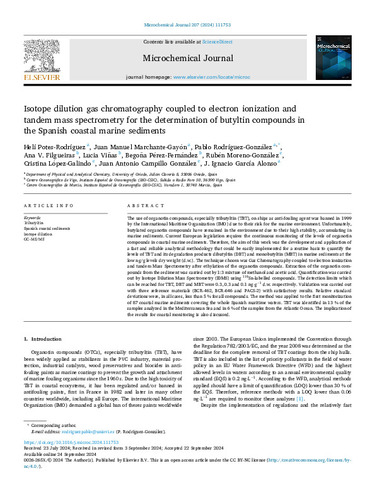Isotope dilution gas chromatography coupled to electron ionization and tandem mass spectrometry for the determination of butyltin compounds in the Spanish coastal marine sediments
Palabra(s) clave:
Tributyltin Spanish coastal sediments Isotope dilution GC–MS/MS
Fecha de publicación:
Resumen:
The use of organotin compounds, especially tributyltin (TBT), on ships as anti-fouling agent was banned in 1999 by the International Maritime Organization (IMO) due to their risk for the marine environment. Unfortunately, butylated organotin compounds have remained in the environment due to their high stability, accumulating in marine sediments. Current European legislation requires the continuous monitoring of the levels of organotin compounds in coastal marine sediments. Therefore, the aim of this work was the development and application of a fast and reliable analytical methodology that could be easily implemented for a routine basis to quantify the levels of TBT and its degradation products dibutyltin (DBT) and monobutyltin (MBT) in marine sediments at the low ng/g levels dry weight (d.w.). The technique chosen was Gas Chromatography coupled to electron ionization and tandem Mass Spectrometry after ethylation of the organotin compounds. Extraction of the organotin compounds from the sediment was carried out by 1:3 mixture of methanol and acetic acid. Quantification was carried out by Isotope Dilution Mass Spectrometry (IDMS) using 119 Sn-labelled compounds. The detection limits which can be reached for TBT, DBT and MBT were 0.3, 0.3 and 0.1 ng⋅g 1 d.w. respectively. Validation was carried out with three reference materials (BCR-462, BCR-646 and PACS-2) with satisfactory results. Relative standard deviations were, in all cases, less than 5 % for all compounds. The method was applied to the first monitorization of 87 coastal marine sediments covering the whole Spanish maritime waters. TBT was identified in 13 % of the samples analyzed in the Mediterranean Sea and in 6 % of the samples from the Atlantic Ocean. The implication of the results for coastal monitoring is also discussed.
The use of organotin compounds, especially tributyltin (TBT), on ships as anti-fouling agent was banned in 1999 by the International Maritime Organization (IMO) due to their risk for the marine environment. Unfortunately, butylated organotin compounds have remained in the environment due to their high stability, accumulating in marine sediments. Current European legislation requires the continuous monitoring of the levels of organotin compounds in coastal marine sediments. Therefore, the aim of this work was the development and application of a fast and reliable analytical methodology that could be easily implemented for a routine basis to quantify the levels of TBT and its degradation products dibutyltin (DBT) and monobutyltin (MBT) in marine sediments at the low ng/g levels dry weight (d.w.). The technique chosen was Gas Chromatography coupled to electron ionization and tandem Mass Spectrometry after ethylation of the organotin compounds. Extraction of the organotin compounds from the sediment was carried out by 1:3 mixture of methanol and acetic acid. Quantification was carried out by Isotope Dilution Mass Spectrometry (IDMS) using 119 Sn-labelled compounds. The detection limits which can be reached for TBT, DBT and MBT were 0.3, 0.3 and 0.1 ng⋅g 1 d.w. respectively. Validation was carried out with three reference materials (BCR-462, BCR-646 and PACS-2) with satisfactory results. Relative standard deviations were, in all cases, less than 5 % for all compounds. The method was applied to the first monitorization of 87 coastal marine sediments covering the whole Spanish maritime waters. TBT was identified in 13 % of the samples analyzed in the Mediterranean Sea and in 6 % of the samples from the Atlantic Ocean. The implication of the results for coastal monitoring is also discussed.
Colecciones
- Artículos [37548]
- Química Física y Analítica [639]
Ficheros en el ítem





